Intercity Connections: Navigating a Volatile Bus Network
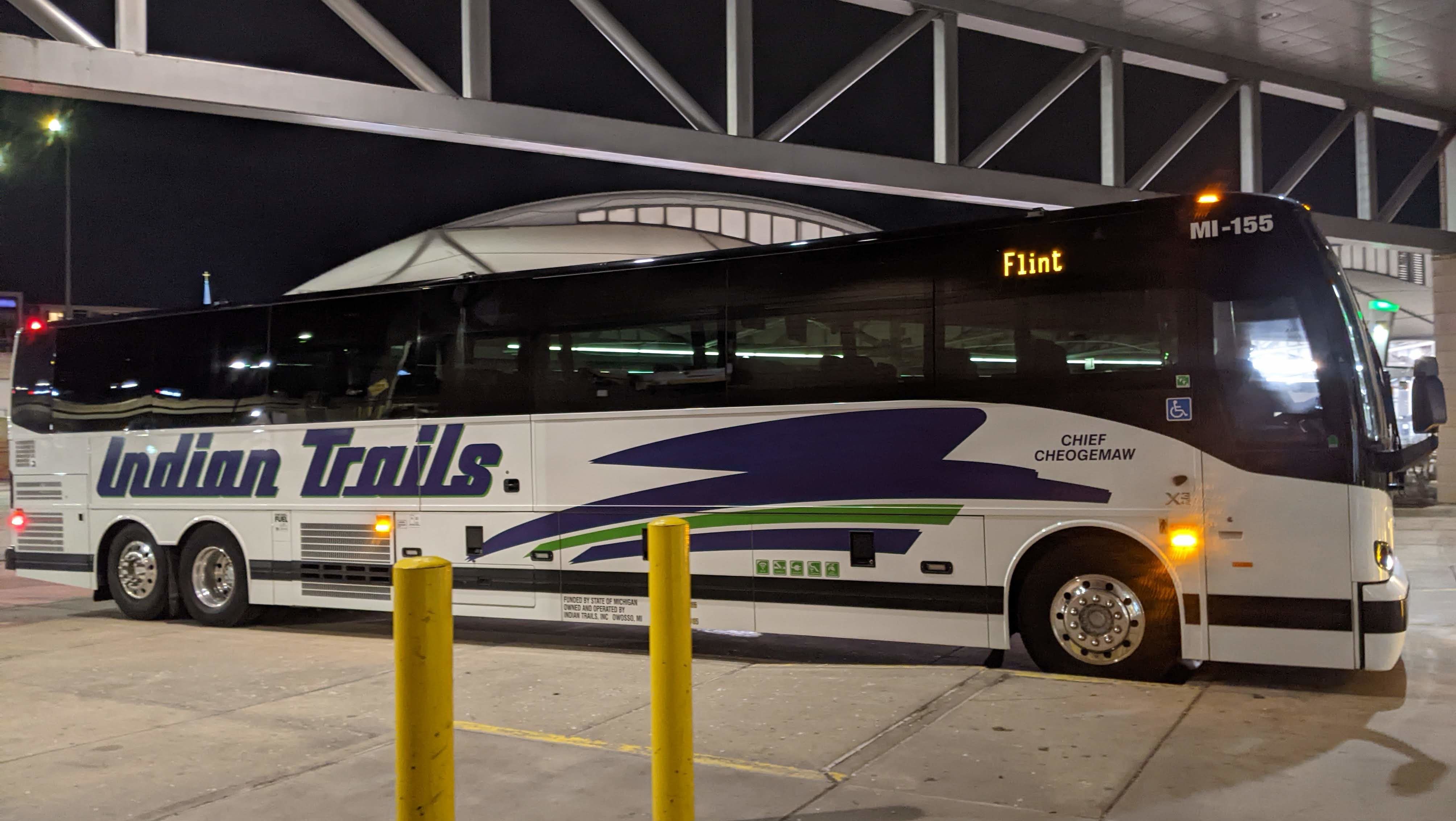
Michigan’s intercity bus network has experienced several fluctuations in service levels and coverage area throughout the past year. Why is this, and what can be done to stabilize it?
Standard disclaimer: This article isn’t sponsored by any of the agencies mentioned within, I’m not getting paid to write this, it’s my own voice, yadda yadda
Did you know the U.S. intercity bus industry is undergoing extensive changes? If you’ve had trouble booking a ticket, it might be because the intercity bus industry is undergoing extensive changes. Likewise, if you can’t find the schedule for your connection, it’s probably because the intercity bus industry is undergoing extensive changes.
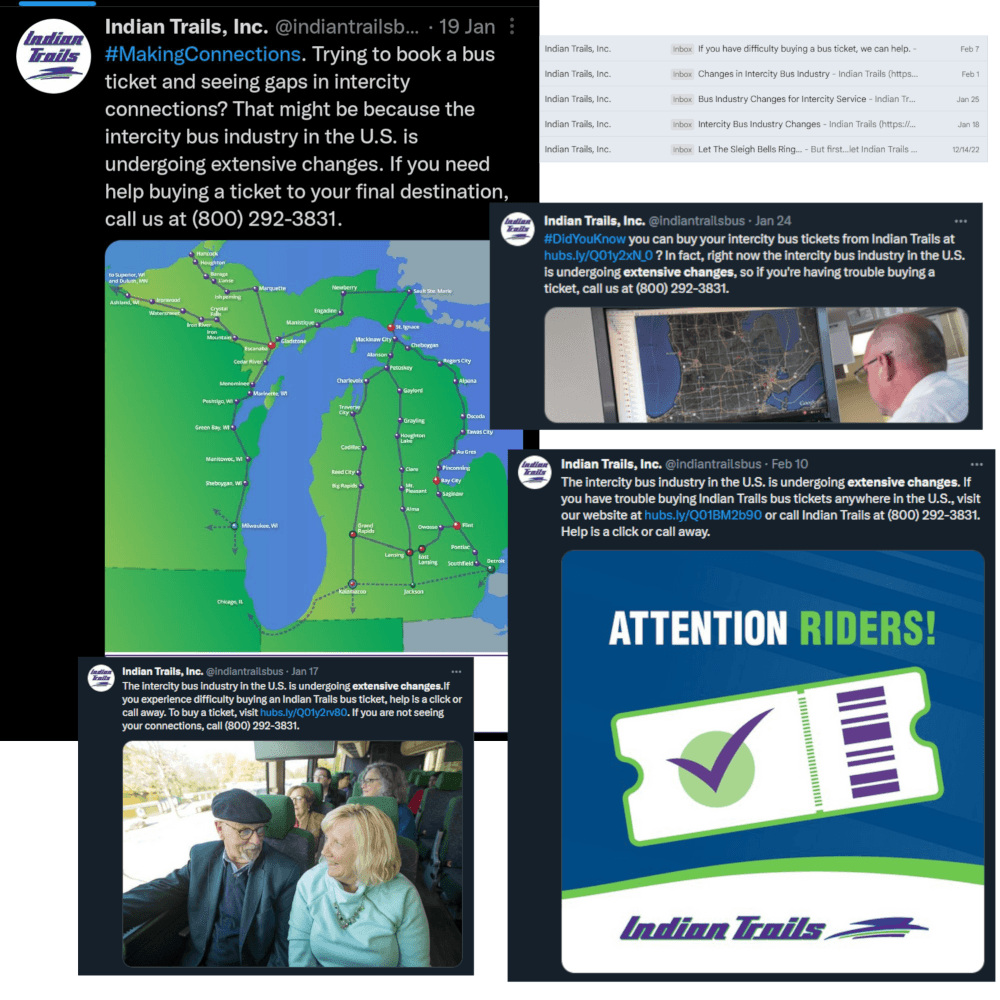
HEY! LISTEN!
Joking aside, lots has happened. Quick overview:
Who’s who in intercity transit
Indian Trails , Michigan’s independent intercity bus operator supported in part by state funding, operates its own “mainline” long-distance routes as well as two special services: The Michigan Flyer , an airport express, and D2A2 , nonstop service between Detroit and Ann Arbor.
FlixBus, an international provider which acquired Greyhound and merged its ticketing system with Greyhound but still kinda sorta runs its own U.S. routes separate from Greyhound - it’s complicated - also operates a few intercity routes in Michigan via private partner agencies like Carr’s Motorcoach and Miller Transportation.
Long story short, Flix/Greyhound terminated all of its interline agreements in February, creating a gaping hole in connecting services that many smaller agencies partnered up to fill . The agency on your ticket might not match the name on the side of your bus nowadays, but you’ll get where you’re goin’ just the same.
The most important thing to understand: Indian Trails is not Flix/Greyhound. The two are entirely separate systems with entirely separate operating practices.
Honorable mention: MTA Flint’s Regional Routes to Auburn Hills and Brighton/Howell, which aren’t technically considered intercity services but effectively function as such because MTA is awesome like that.
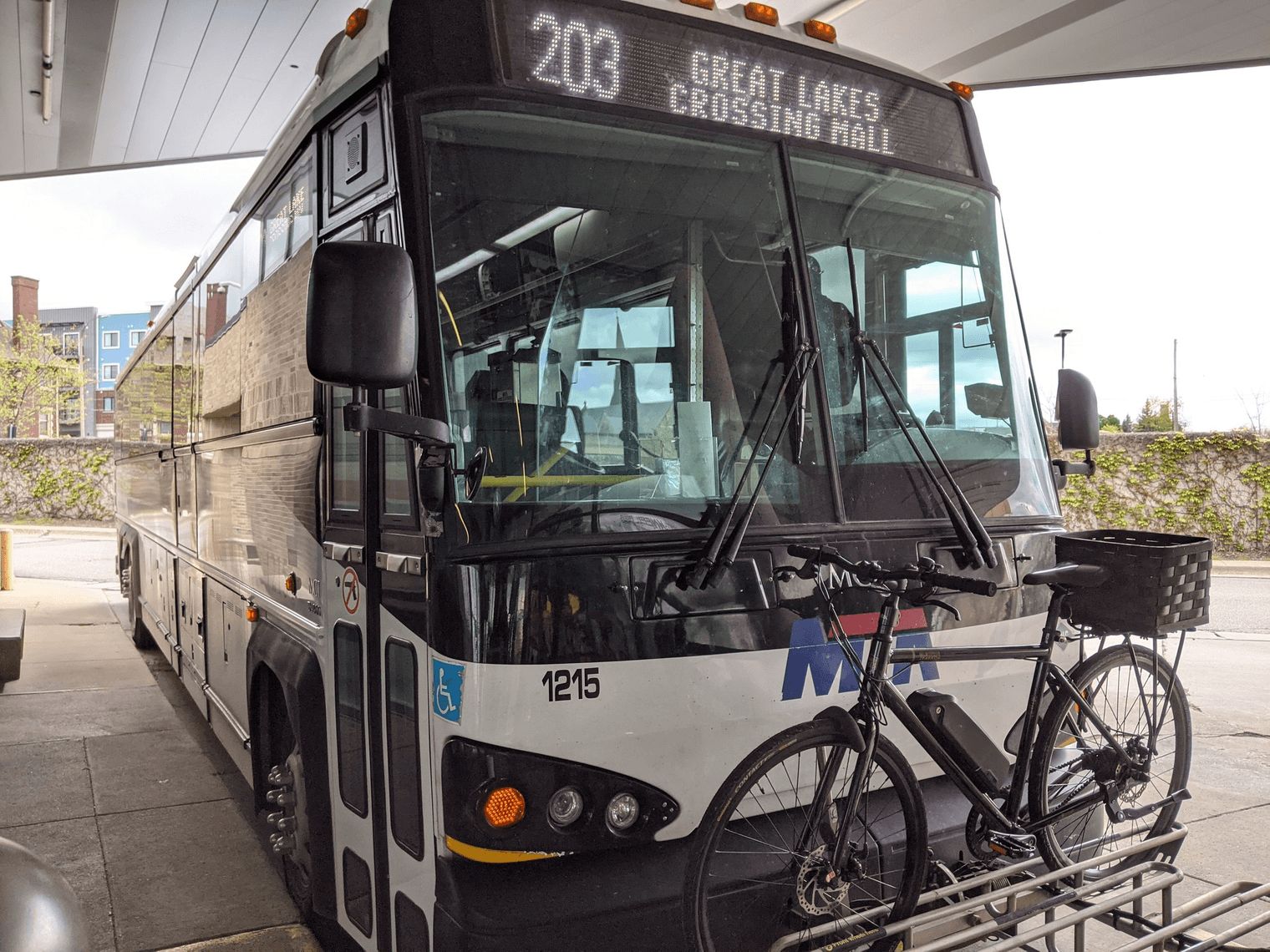
The MTA Regional between Flint and Great Lakes Crossing, Michigan’s only “intercity” bus route that’s operated by a local provider, runs hourly nearly all day, and has coaches equipped with bike racks. It’s a unique local/intercity hybrid that isn’t subject to the points I raise in this writeup.
It’s not rail, but it’s still essential
In the eyes of many local policymakers, intercity motorcoaches are the black sheep of transit. Local city buses offer quick trips, so comfort isn’t much of a concern; Amtrak offers the luxury of food service, multiple restrooms, and the ability to leave your seat and walk around during long-distance trips. Motorcoach service unfortunately offers neither. Your seat might be comfy, but you’re stuck in it for however long your ride is with a single restroom to share with 50 other people. It’s worse still if you’re a fellow COVID-cautious person and aren’t comfortable unmasking around others during the trip (i.e. you can’t eat or drink in between “smoke stops,” of which there are few).
I won’t sugarcoat it. Yeah, I run a blog singing the praises of taking transit anywhere and everywhere, but even I max out at about three hours on one of these buses (unlike another transit advocate who is far, FAR more dedicated than yours truly) . That said, Michigan’s intercity bus system functions as the regional rail system we don’t have and should be afforded the same level of respect and attention by state-level elected officials. It’s not glamorous, but we need it in working order.
Regional transit for a regional pinball
Here’s the gist of my story as an intercity transit rider: I grew up in Grand Blanc , went to college in Detroit / Metro Detroit , then moved to Lansing for work. I’m still involved in transit advocacy in Metro Detroit by way of my role with TRU and still regularly visit my friends and family in Genesee County, so I’m a regular rider on MTA, SMART, DDOT and CATA - everything. When someone asks where I am on any given day, I tell them to throw a dart because I’m a “regional pinball.”
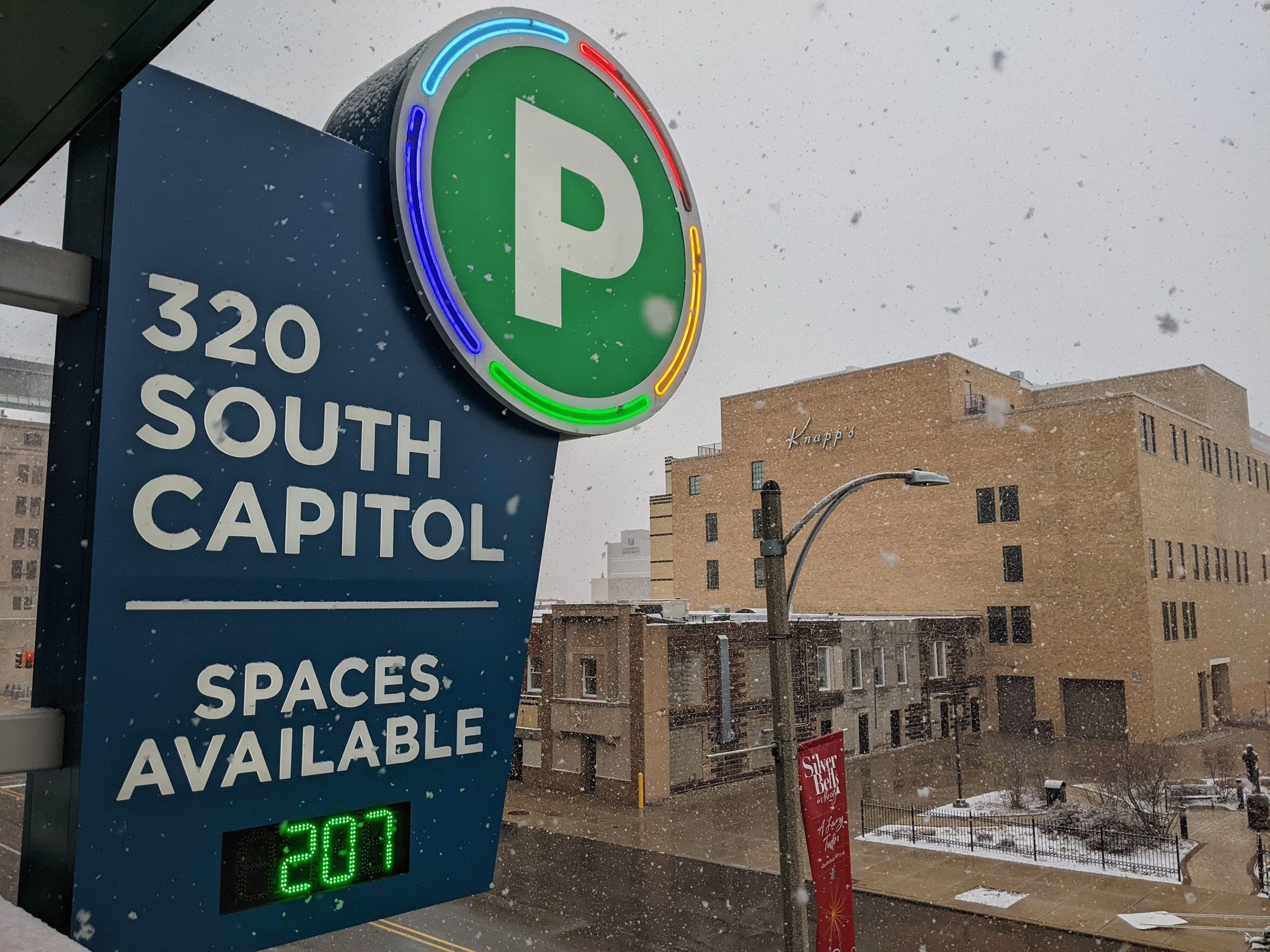
Driving between Detroit and Lansing is not cheap. If any legislators are reading this: I feel your pain. Truly.
Amtrak gets you between Flint and (East) Lansing, but only once a day in each direction at inconvenient times. If you have several hours to spare you can change trains in Battle Creek to get from Lansing to Detroit, but you can’t get back. There’s no passenger rail connection between Flint and Detroit. Enter intercity bus service.
Where’s FlixBus? Not where it was yesterday
In late March, to everyone’s surprise, FlixBus spun up a direct route between Lansing and Grand Circus Park in Detroit that ran five days a week, offering a direct connection to both local transit and D2A2 on the Detroit side.
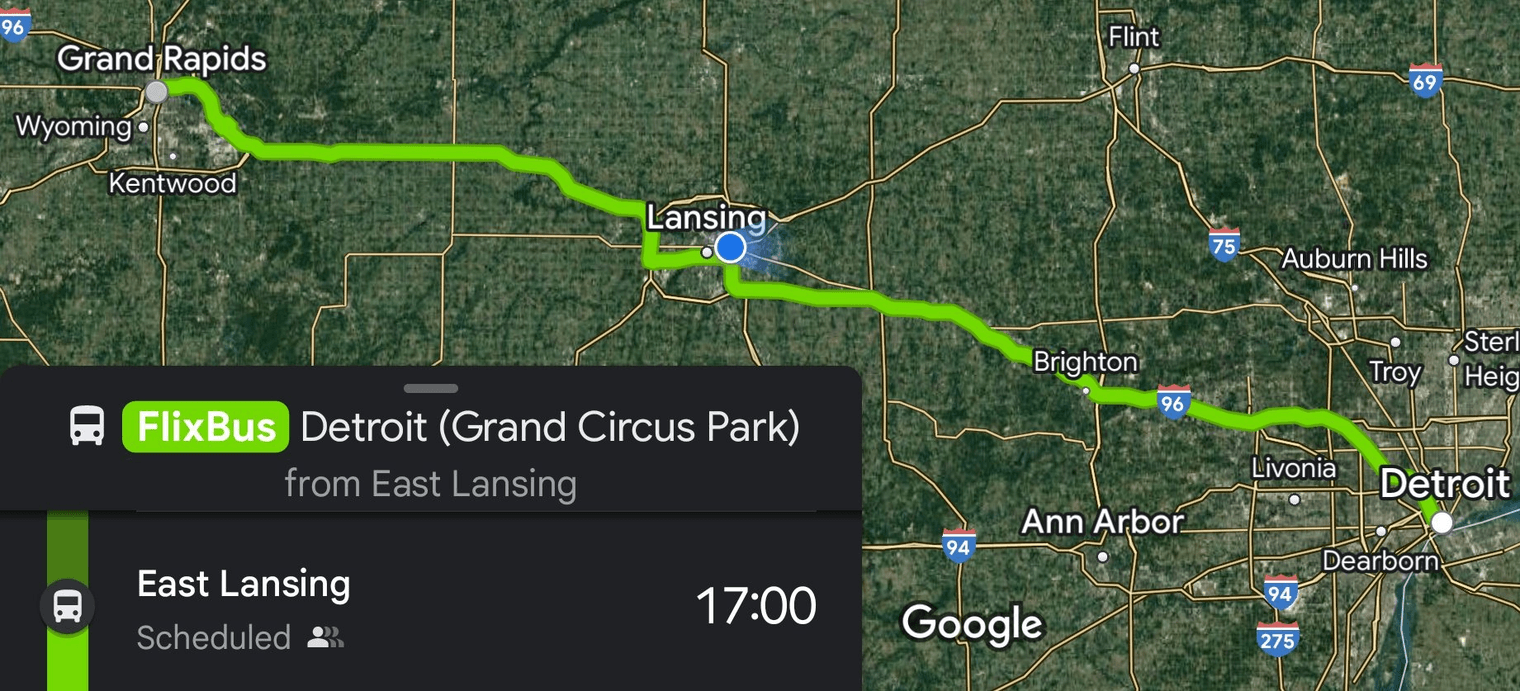
The incredibly short-lived direct connection between Lansing and downtown Detroit. Within a month, Farmington Hills would be added as a stop and the downtown Detroit stop would be relocated to the Howard bus terminal to align with Indian Trails mainline routes and other Flix/Greyhound routes rather than local Detroit services.
It would’ve been perfect, but the pickup point on the Lansing side doomed it: Frandor Burger King. That’s the Greyhound route planning showing through. The Hound heavily relies on gas stations, grocery stores, and fast food parking lots with immediate access to highways as bus stops. No time to lose when you’re traveling coast to coast, even at the expense of any infrastructure whatsoever and … well, being able to walk to the stop at all.
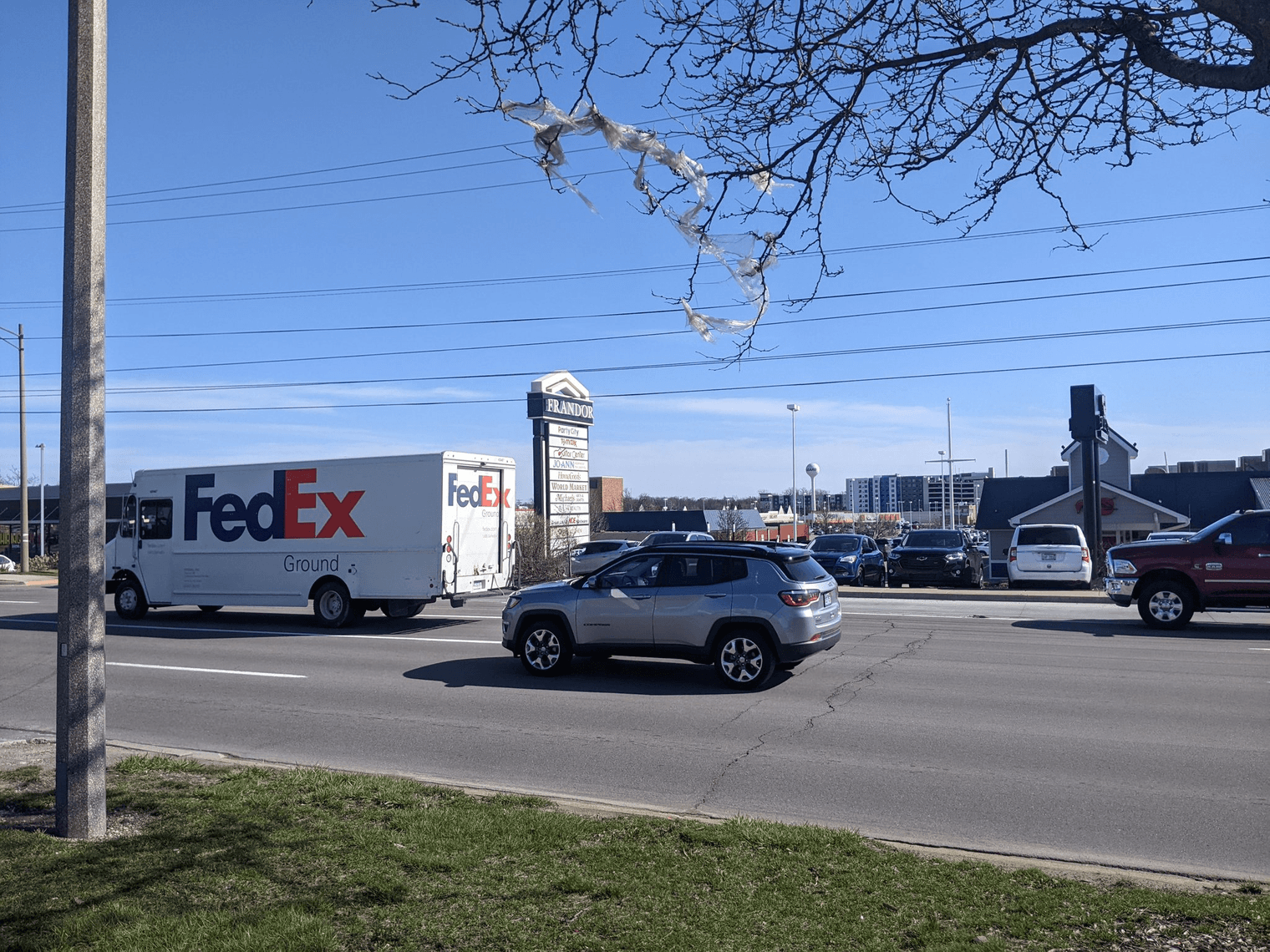

Reaching this FlixBus stop on foot or from CATA requires braving the Frandor Death Zone (FDZ). View original Twitter thread
The stop was moved without warning several times, first from Frandor Burger King to a Sparrow medical center building and, as of three days ago — a change I wouldn’t even have been aware of if I hadn’t been collecting screenshots for this blog post — all the way out to Grand Ledge, which isn’t even served by CATA let alone accessible on foot. It’s clear across 96.
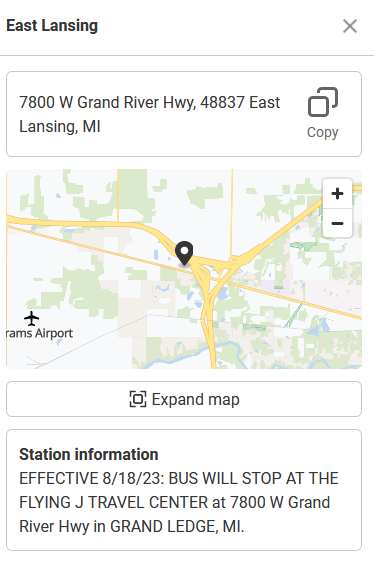
When East Lansing is west of Lansing
(Update, 2024: It moved again! This FlixBus now picks up at Lansing Mall, at the CATA Route 3 stop.)
Out of sight, out of mind. That’s the name of the game when you’re riding Flix/Greyhound. Headed to a major city? An outer suburb gas station is as close as it can get you without stirring up local officials or business owners, so you’ll have to figure out the rest.
Indian Trails: A good system with growing pains
Indian Trails, on the other hand, makes a concerted effort to connect riders to local transit agencies, often sharing operating space and even employees at transit centers. It’s the spoils of state funding.
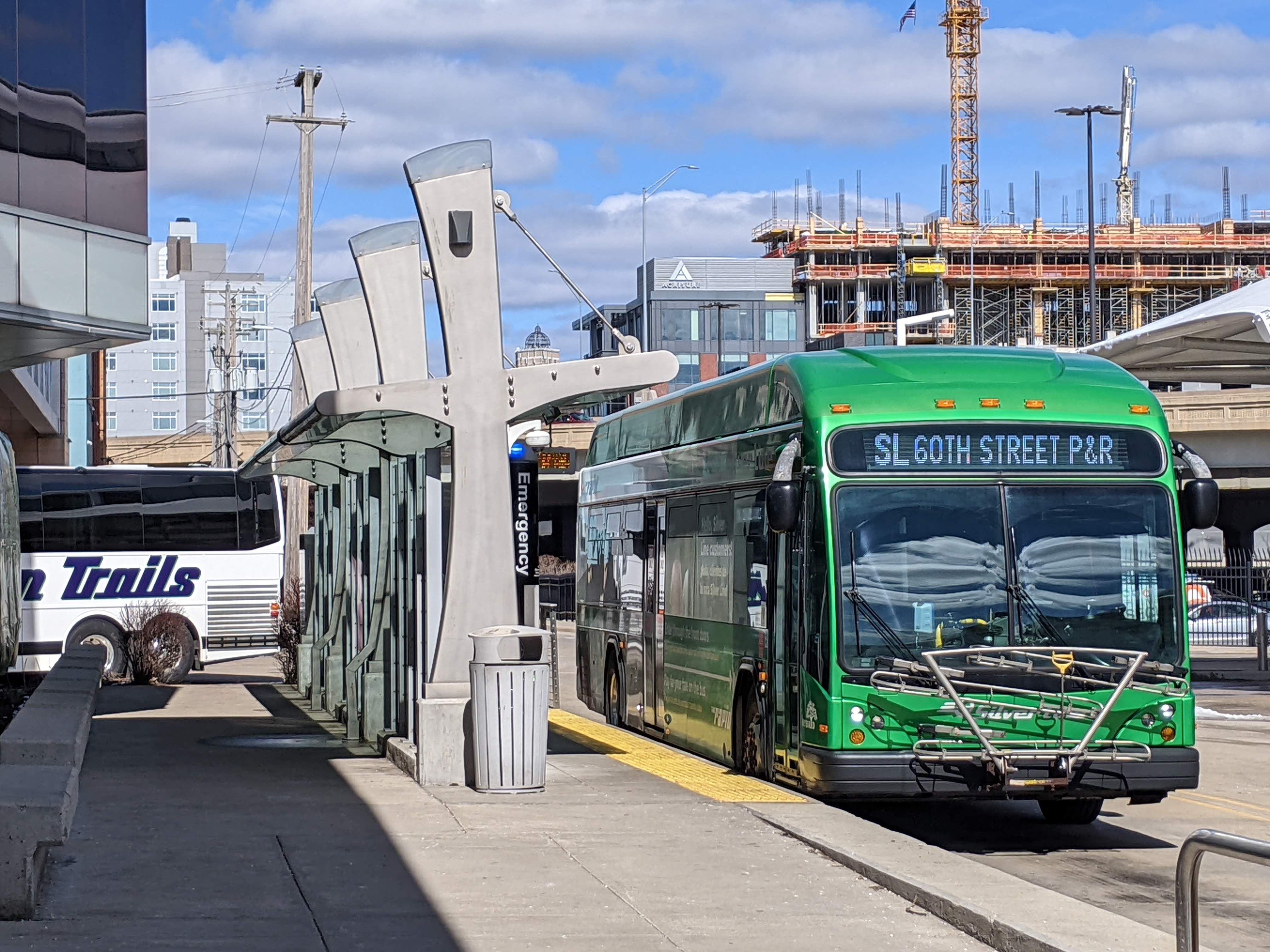
See how Trails pulls right into the bus station, allowing for direct connections? This is where it excels, and why it’s always a better option than Flix/Greyhound for intercity travel within Michigan.
Greyhound has an unfortunate reputation as the bus company nobody wants to see or deal with in their own town. Nearly all Greyhound routes are interstate routes which rarely run to schedule and mostly provide critical lifeline service to riders with no other means of travel. This regrettably means that intercity bus service gets a bad rap because in the mind of the public, it’s the same thing. People confuse Indian Trails with Greyhound all the time: Similar service on the same type of bus, but it’s locally owned and operated by Michigan-based drivers and primarily serves Michigan travelers.
Trails runs good service. But unfortunately, it’s suffering from some growing pains .
Back in March, Trails restored mainline service between Detroit and Chicago for the first time in many years. As a byproduct of this an evening trip between Grand Rapids and Flint via Lansing was newly introduced, enabling day trips between the cities.
Six months later, before the route was in service long enough for ridership to stabilize, Trails is scaling this back. The same pool of operators keeps mainline routes, the Flyer, and D2A2 running, and like every other operator across the country, they’re facing a shortage. Trails has to keep the shorter, more frequent Flyer and D2A2 routes running even if it’s at the expense of the longer trips across the state.
The Flyer is the near-hourly airport shuttle between East Lansing, Brighton, Ann Arbor, and Detroit Metro Airport. It’s Indian Trails’s crown jewel, complete with advertisements on billboards and even a theme song. Yes, it plays on the bus when you board. Watch on YouTube
Hostility towards transit riders from locals and MDOT alike
Classic Michigan animosity towards transit riders reared its ugly head recently when, in typical suburban fashion, a small group of residents made baseless, hateful claims about Greyhound passengers in Davison , after which the township police ultimately sided with them and forcibly shut down an established bus stop at Meijer. Greyhound attempted to preserve access to the Flint area by moving to the Dixie Highway MDOT Park and Ride lot in Grand Blanc Township, but were told to leave by police again . The Atlanta-to-Flint route terminates at Great Lakes Crossing now, billed as “Flint-Auburn Hills” on the itinerary. Mercifully, Great Lakes Crossing hasn’t forced yet another relocation as of now.
At this point MDOT chimed in, claiming that state-owned carpool lots are not authorized for use as public bus stops and were never built to accommodate such a purpose. I personally challenge this based on infrastructure I’ve seen myself at various P&R lots that’s clearly intended for use by buses.
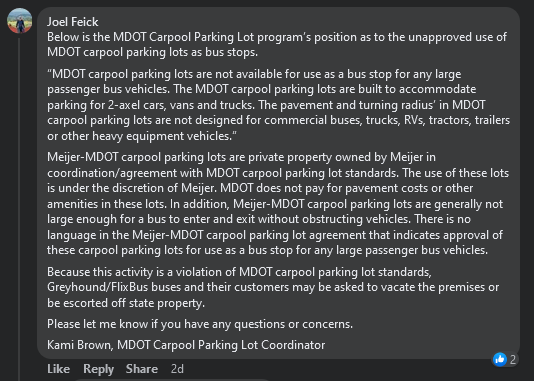
Joel Feick is a Grand Blanc Township Trustee. He relayed this message from MDOT after the actions of Grand Blanc Township police drew public attention.

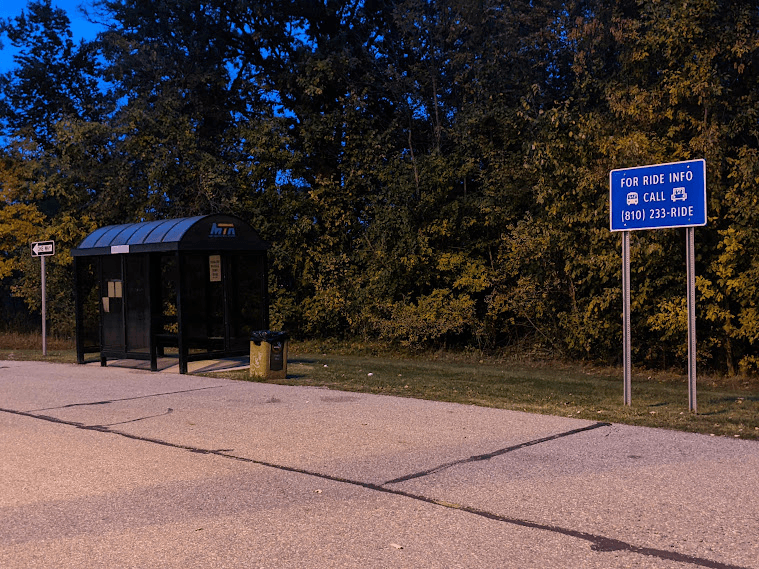

Exhibits A, B, and C: Official MDOT Park and Ride Lots in Grand Blanc Township, Fenton, and Bridgeport, respectively. Two have shelters, one of which is actively served by MTA when riders request a deviation. All have ring-road setups for buses.
Something’s fishy here, and it’ll take some local history investigating to get to the bottom of it. But one thing’s for certain: As per usual, MDOT’s long-standing contempt towards anyone who isn’t operating a private motor vehicle is part of the problem, and that can only be fixed by better legislation and a culture change within departmental leadership.
Update, October 2023: MDOT’s determination that transit buses cannot use Park and Ride lots has begun to cause problems with local SMART service as well. The newly-extended Routes 305 and 740 can’t pull into Wixom Meijer , and Route 805, a peak-hour commuter service which was extended at the same time, was not allowed to enter the Beck Road P&R lot.
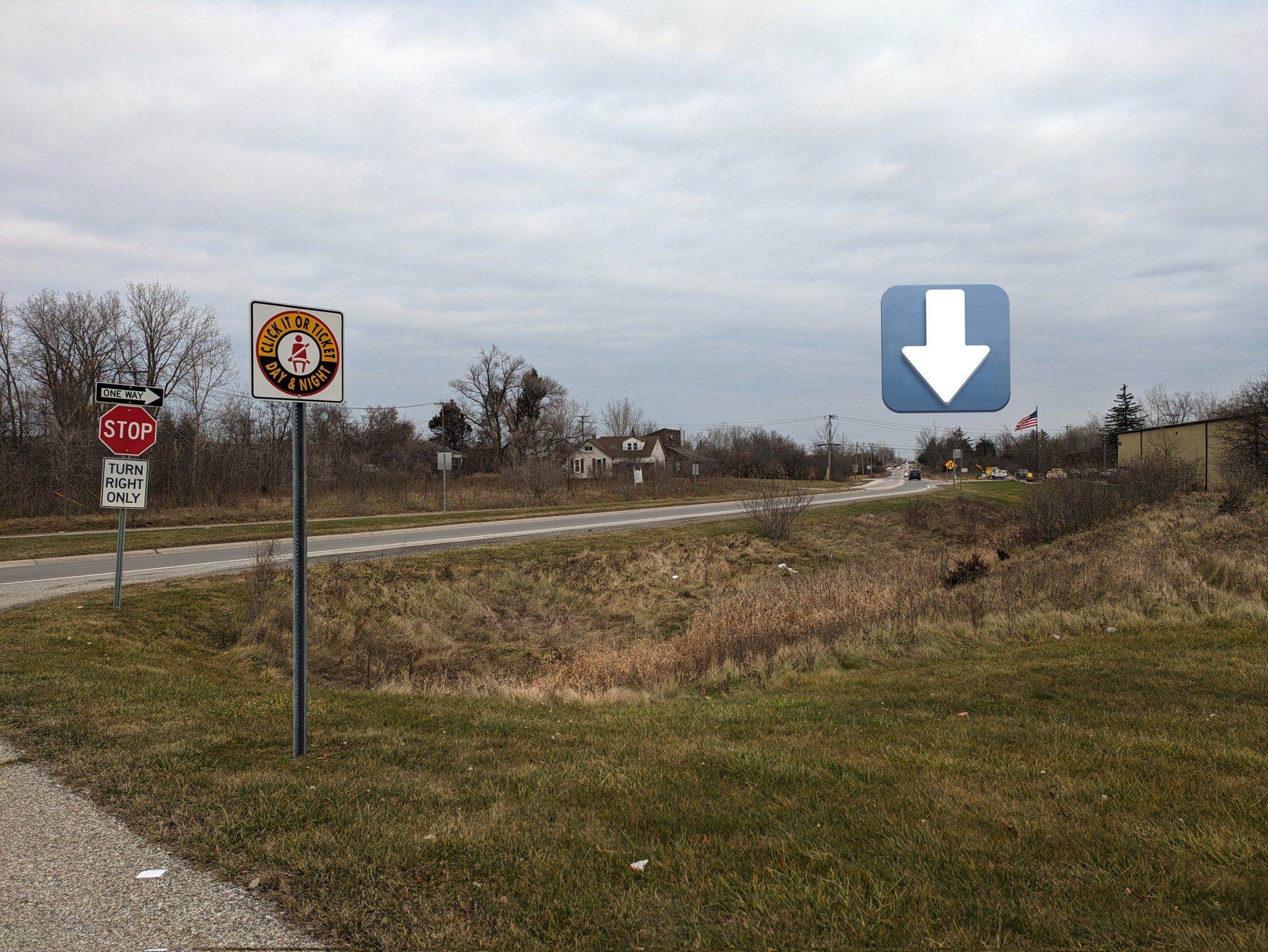
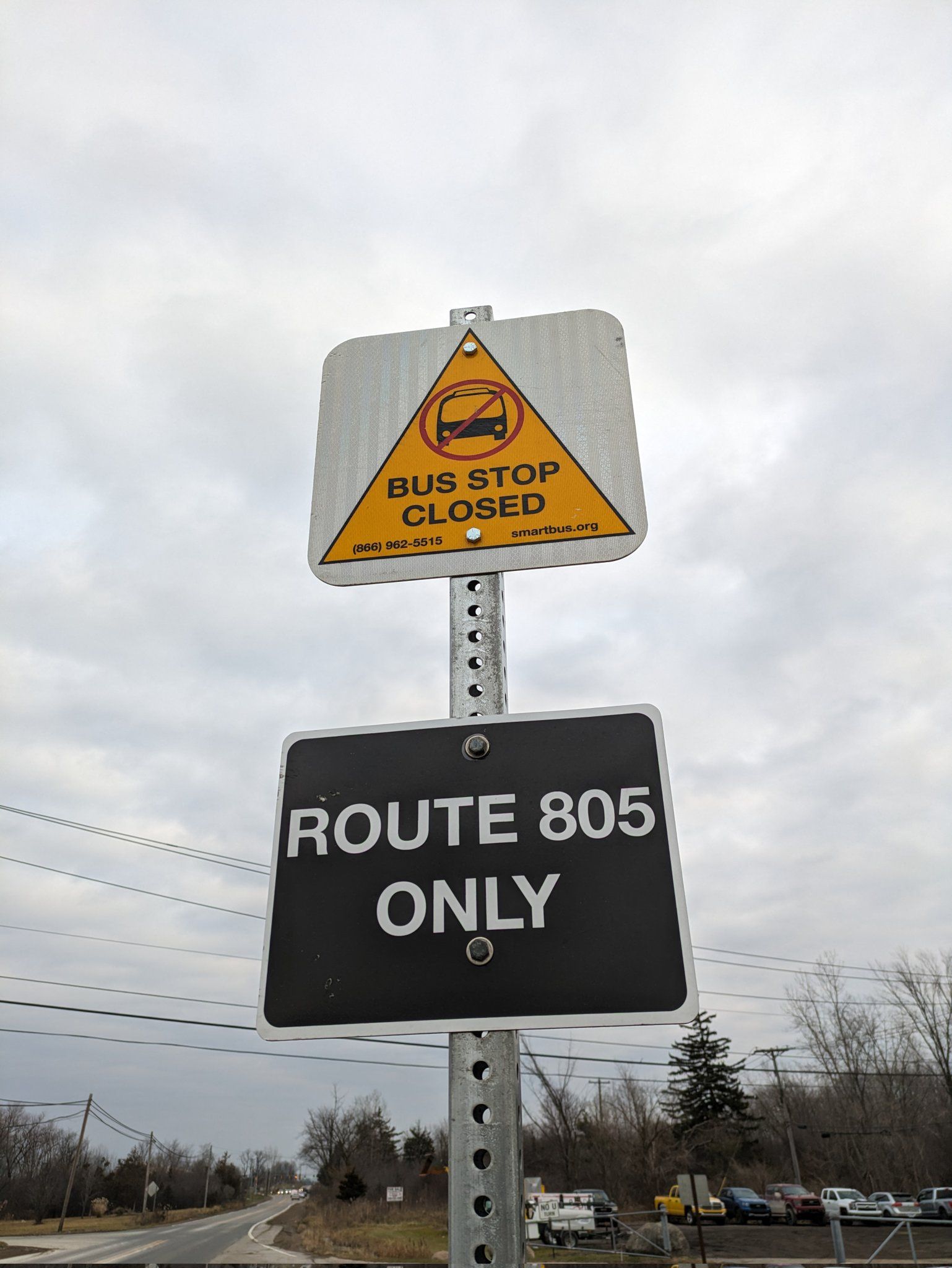
Effective October 16th, SMART Route 805 no longer stops outside the Beck Road Park and Ride Lot due to safety concerns with riders crossing this ditch. The route never served the lot itself due to MDOT’s refusal to grant SMART access. A similar change occurred at Brown Road Meijer in Auburn Hills, though in that instance, it was the property managers who forced SMART to board from the street rather than from the lot.
October 12, 2023 • 3:43 pmHi Corey! We recommend contacting the MDOT Carpool Lot Program staff with that question: MDOT-Carpool-Parking-Lots@Michigan.gov or 517-241-2400.
Hope this helps. Thanks for following MDOT!
An attempt to reach out to MDOT to address this situation was less than helpful, as the Carpool Lot Program staff are the individuals who enacted the policy against buses in the lots to begin with.
Local security and police also need to cut the hostility towards anyone who dares linger in a train station or at a bus stop.
March 12, 2023 • 3:30 amthis is a message to all transit agencies
if there are still buses scheduled to arrive at or depart from your station, whether they are operated by you or not
DON'T LOCK YOUR BUILDING
signed,
a cold michigander who's just trying to get home like everyone else
Seriously. Stop it. Don’t make me stare at a vending machine through a locked door. It’s actual torture.
Where do we go from here?
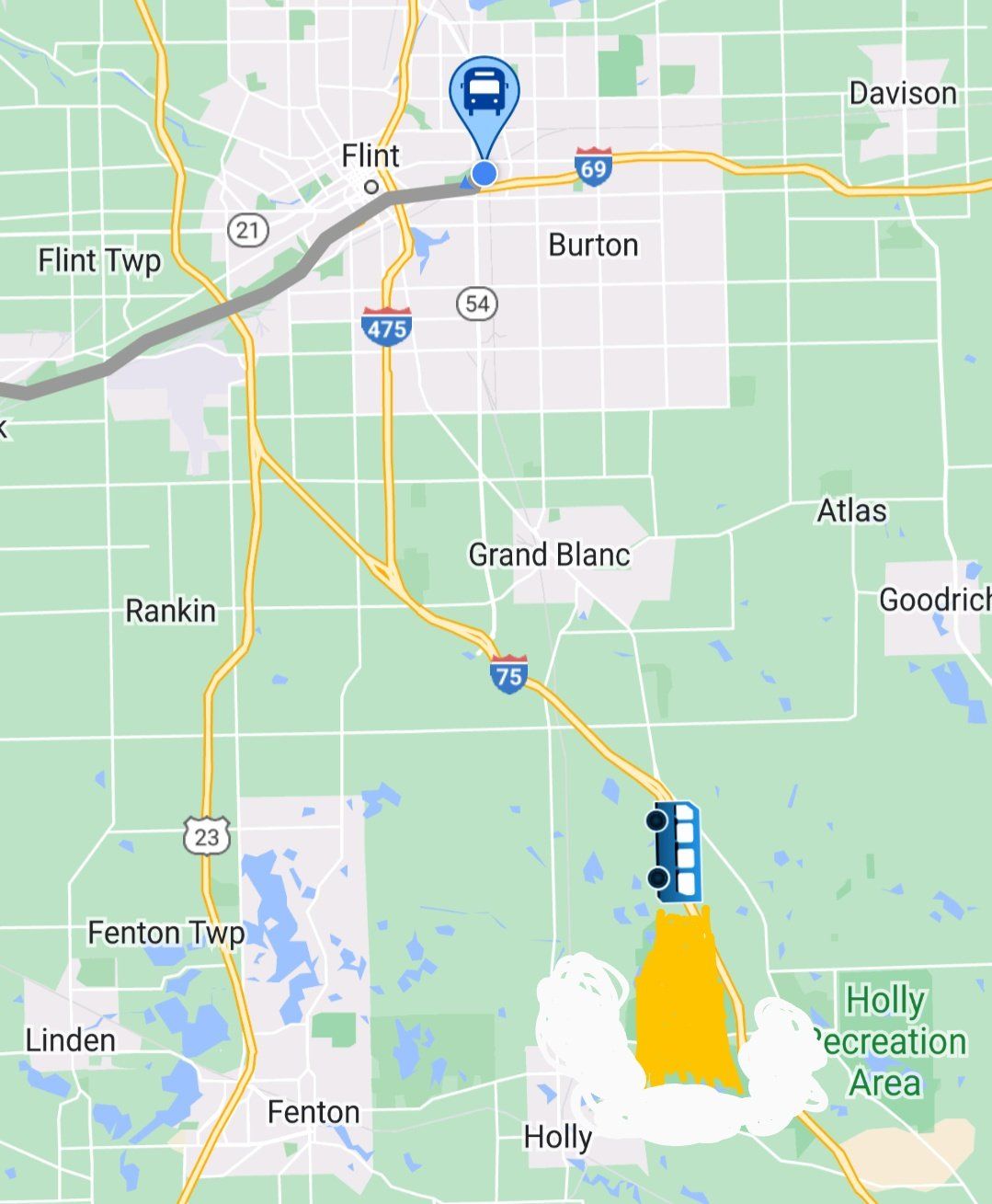
Mission Control to Indian Trails 0021, you are go for de-orbit burn
The hallmark of a strong intercity system is frequent, direct travel between trip generators: major cities, major transfer points.
This is why MTA’s Great Lakes route does so well for itself and is able to sustain such a high frequency and service span: Nonstop service with solid connections at each terminus. Same goes for D2A2 and the Michigan Flyer.
We can’t do much about Flix/Greyhound other than being a little more welcoming, but Indian Trails is our own system to shape. My two most frequent trips on Trails have been East Lansing to Flint and Lansing to Grand Rapids. Both of these trips are direct, two of only three such trips in the system - the other being Grand Rapids to Kalamazoo. Hop on, ride, hop off. No waiting at intermediate stops, no waiting on a driver swap because a connecting bus is an hour late - just simple bus travel between two points. Any longer than that and it starts to get painful.
An intercity agency’s goal should be to get passengers off their buses as fast as possible while providing as much service as possible. Other state-funded intercity agencies, such as the oft-cited Bustang in Colorado , have built schedules that prioritize frequent, direct travel between cities and have consequently watched ridership and public awareness soar. Indian Trails will ultimately have to decide what it wants to be: A lifeline service designed for maximum coverage, or a high-ridership service designed for efficient travel. Both are valid options, but Michigan is in desperate need of the latter.
Maybe Trails steps up. Maybe a new state-supported service that isn’t stretched as thin enters the arena - the new trifecta is making moves on transit funding . However we approach it, solving this is a must because right now, congested, deadly expressway travel is the only option most Michiganders have.

Michigan wants to talk about population growth? Young people will not move here if this is the best transit experience we have to offer.
For now, Indian Trails is the next-best thing to Amtrak we have in Michigan. It’s functional - I’m able to get where I need to because we have it, even if it means building my schedule around its limited service. But as a state, we can do better. Look to other states that have already gotten this right and replicate their efforts. A little state funding can go a long way, and we have the energy in Lansing now - we just have to direct it. Start conversations with your electeds, because most of them likely don’t even have an opinion on intercity transit. Show them it’s an issue, and they just might take action to make better intercity service a reality.
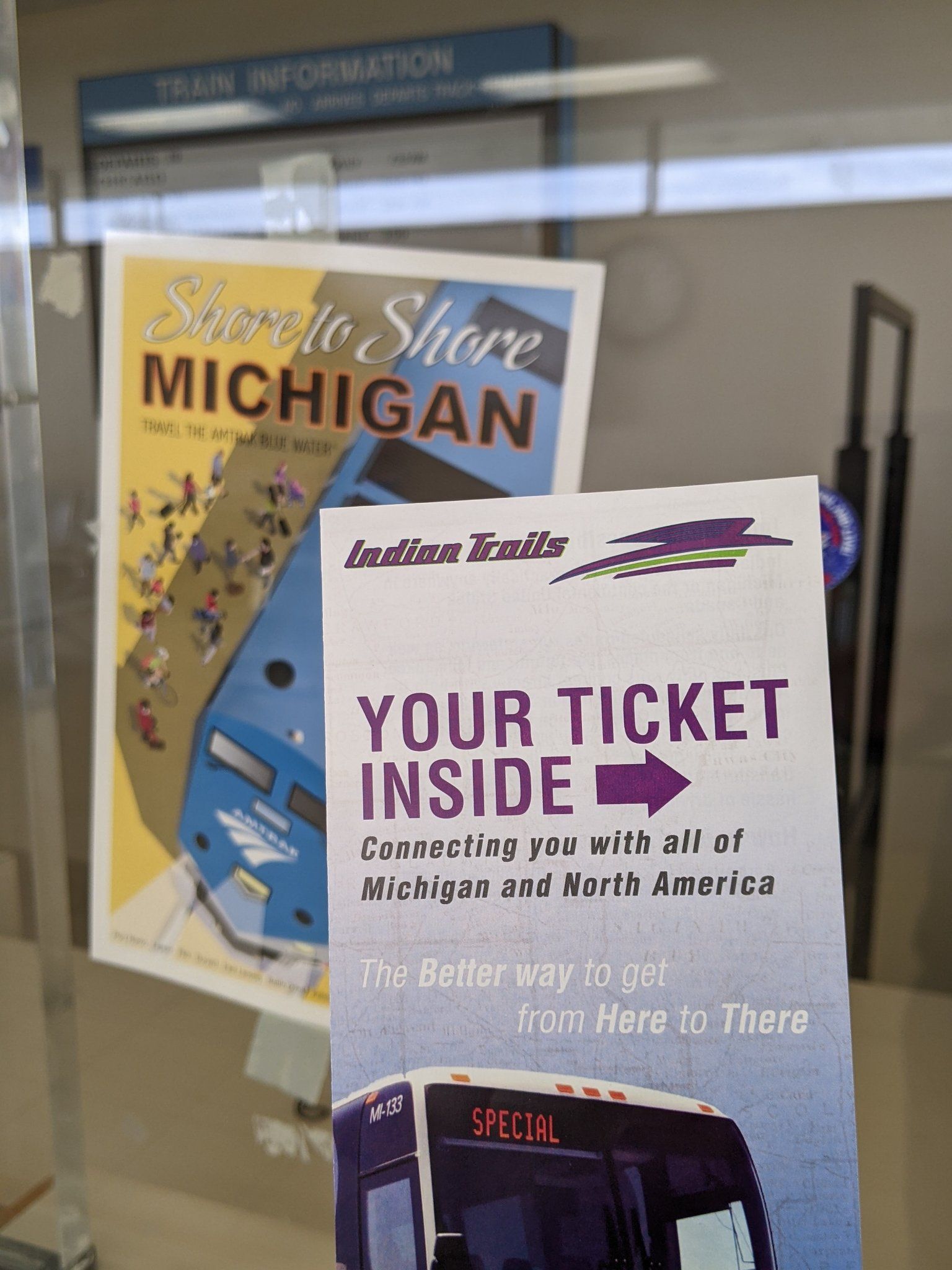
But really, let’s eventually have that conversation about building more trains.
 Michigan DOT
Michigan DOT  Corey
Corey